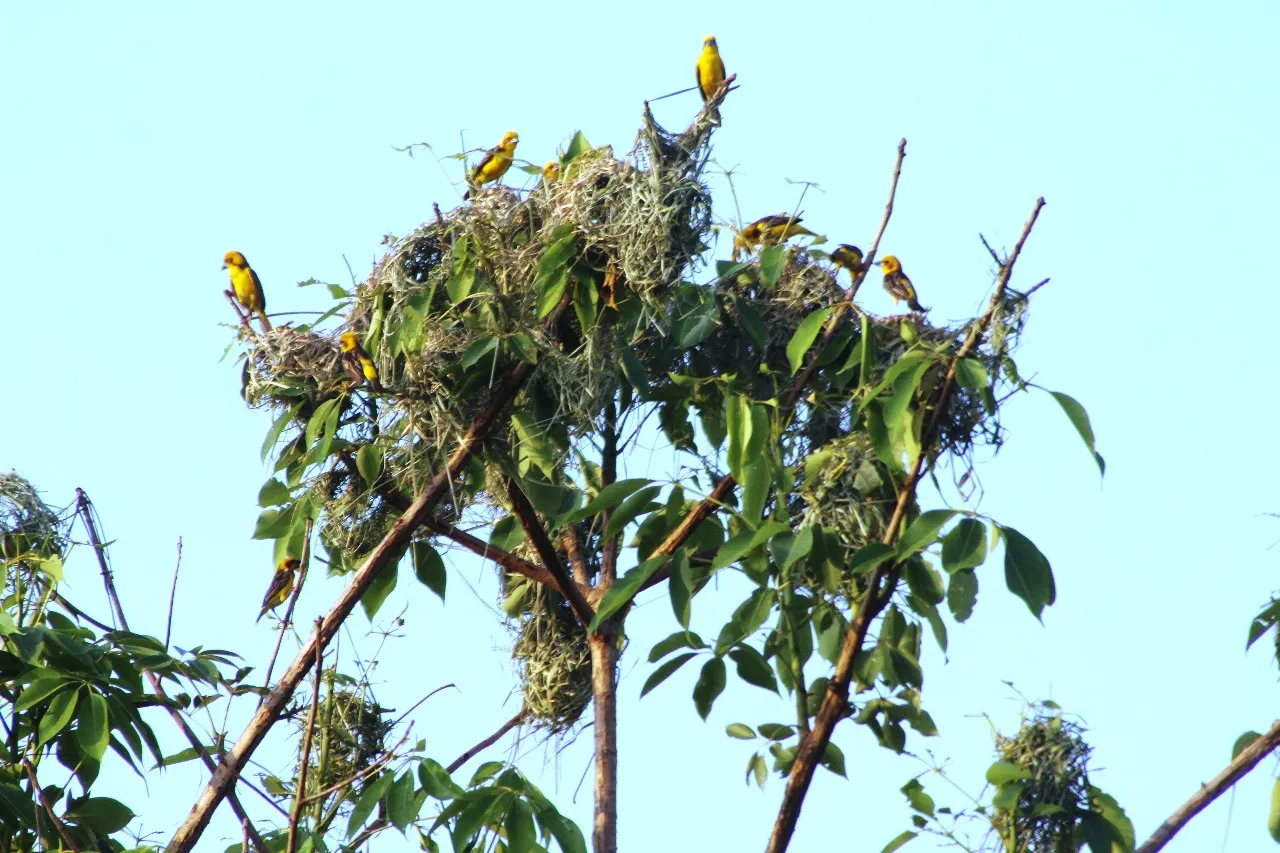A special census of the globally rare and critically endangered Golden-Backed Weaver bird (locally known as SunauLo Top) has officially commenced today at Shuklaphanta National Park in far-western Nepal. The census is being conducted jointly by the Nepal Bird Conservation Association (Bird Conservation Nepal – BCN) and Shuklaphanta National Park, aiming to gather critical data to aid the species’ long-term conservation.
Five-Day Technical Survey in Core and Buffer Zones
A team of eight experts from the park and BCN has been mobilized to conduct the bird count over the next five days. The team will use binoculars, GPS, cameras, field observation techniques, and even elephant rides to access dense and remote areas of the park that are otherwise unreachable on foot.
According to bird expert Hiralal Dagoura from BCN, the survey will include both core areas inside the national park and select buffer zone regions outside its perimeter. “We will conduct a ground-based survey in locations that are accessible by walking. For more remote terrains, we’ll use elephants,” Dagoura explained.
The external survey will span two days and focus on zones adjacent to the park where the species might be spotted. Key habitats targeted in the census include Sikari Taal, Shuklaphanta, Maluwabela, Lalpani, Haraiya Phanta, Panchhi Taal, Veersingh Tapu, Sundariphanta, Singhpurphanta, Radhapurphanta, Badhni Khera, and Andaiya-Pataya areas.
Comprehensive Study: From Nesting Habits to Threat Analysis
Beyond merely counting individuals, the census aims to gather detailed data about the species’ breeding habits and environmental preferences. The researchers will record the number of males and females, observe nest locations and tree species used for nesting, measure the height of nesting trees, document local grass species, study available food sources, and assess threats posed by predators and human activities.
“This is more than just a headcount,” said Dagoura. “We’re collecting habitat data, monitoring nesting behavior, and assessing threats so we can plan effective conservation strategies.”
Nepal’s Exclusive Habitat for the Endangered Bird
According to Park Ranger Prayas KC, the Golden-Backed Weaver is only found in Nepal and India, making it a species of high conservation priority. In Nepal, it is found solely in Shuklaphanta National Park, which spans 305 square kilometers. The bird prefers to nest in the open grassland habitats unique to this park and is rarely sighted elsewhere.
“These birds nest artistically on tree branches by weaving leaves intricately, hence the name ‘Weaver bird’. They build their nests and raise chicks during the monsoon, which is their peak breeding season,” KC explained. “They are social birds that nest, roost, and forage in groups.”
The Golden-Backed Weaver was first officially recorded in the park in 1996. Since then, the park has consistently documented and worked toward protecting this unique species. KC noted that approximately 100 individuals are believed to currently inhabit the area.
The bird’s name is derived from its striking golden-yellow plumage, which gives it a distinctive appearance. Locally, it is often mistaken for a species of oriole or golden finch due to its color and behavior.
Ecological Role and Cultural Significance
Park Conservation Officer Purushottam Bagale highlighted the bird’s vital ecological role, particularly its appetite for insects, which makes it a natural ally to local farmers. “Golden-Backed Weavers feed on insects and pests, making them helpful in controlling crop-damaging insects. That’s why they are often referred to as the farmers’ friends,” Bagale said.
He also mentioned the bird’s social behavior as a unique trait, with the species known for collective nesting and group foraging activities. This behavior has prompted researchers to classify it as a social bird species, often forming small colonies during the breeding season.
The Golden-Backed Weaver prefers nesting on thorny trees near wetlands and lakes, especially in buffer zones and marshy lands close to the national park. These features make it an important bio-indicator species for monitoring the health of wetland and grassland ecosystems.
A Haven for Over 400 Bird Species
Shuklaphanta National Park is renowned for its rich biodiversity and is home to more than 400 species of birds, making it one of Nepal’s most important bird habitats. The current census and ongoing conservation efforts are part of broader biodiversity protection initiatives within the park.
The current survey’s findings will inform national and international conservation agencies working to protect endangered birds in South Asia. Data collected from the field will help determine whether the Golden-Backed Weaver’s population is stable, increasing, or in further decline, and what specific interventions are needed to ensure its survival.
Safeguarding a Rare Jewel of the Grasslands
With climate change, habitat loss, and predation posing significant threats to Nepal’s native bird species, conservation efforts like this census are vital. The Golden-Backed Weaver, seen as both ecologically beneficial and culturally significant, represents a living emblem of Nepal’s natural heritage.
As researchers set out into the wild grasslands and wetlands of Shuklaphanta this week, their work could pave the way for more informed policies and stronger protection of Nepal’s rare and endangered avian species. The success of this initiative could not only help preserve a unique species but also support broader conservation models across South Asia.




